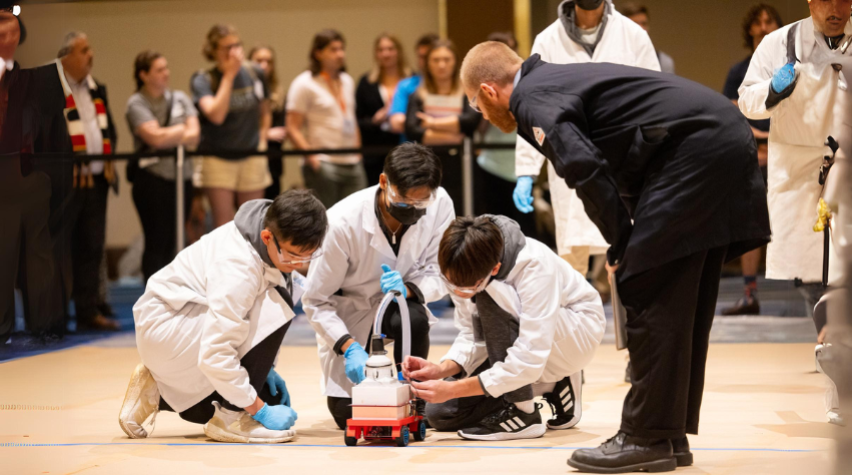
Students prepare their car to make a run at the 2023 Chem-E-Car Competition.
If you’re just joining the story of the AIChE Chem-E-Car Competition®, begin with Part 1.
At the start of the Chem-E-Car Competition, ten separate competitions were held each year in North America. Nine qualifying events took place at spring AIChE Student Regional Conferences, and a final contest for the 31 top regional teams took place at the Annual Student Conference. A preliminary poster session allowed teams to illustrate the construction, safety components, and chemical reaction involved in each car’s design. Prizes were presented for on-the-track performance as well as for engineering and design components.
Volunteer leaders of the Chem-E-Car Committee (a subcommittee of the SCC) coordinated the competitions and maintained the rules, which have been revised and refined annually to address safe design and operating standards, and to better instruct competition organizers and participants. Charter members of the rules and supervision committee included chemical engineering professors David Dixon, Robert Ofoli, George Roberts, Skip Rochefort, and Richard Zollars — several of whom continued to supervise the finals in 2023.
Chem-E-Car becomes a global phenomenon
The Competition eventually captured the attention of people outside AIChE and the Institute’s existing network of chartered student chapters. In 2005, an International Chem-E-Car Competition, modeled on AIChE’s competition, was held in Glasgow, Scotland, in connection with the IChemE-sponsored Seventh World Congress of Chemical Engineering. The AIChE team from the University of Tulsa (then, the reigning AIChE Chem-E-Car Competition champion) traveled to the World Congress and won that competition as well. By 2008, nearly 100 schools in North America had become involved in annual Chem-E-Car Competition activities.
Participation would rise in subsequent years, as AIChE’s network of student chapters grew around the world. In fact, with AIChE membership being a prerequisite to participate in AIChE-sanctioned Car Competitions, Chem-E-Car became an important tool for recruiting undergraduate student members internationally.
Safety education given new emphasis
In early 2006, the Student Chapters Committee and AIChE Board of Directors received reports of inconsistent safety supervision at some regional Chem-E-Car Competitions. The Board suspended the competition until a plan could be activated to address problems and prevent the possibility of mishaps.
In addition to ensuring participants’ and spectators’ safety through more thorough supervision of the competition series, AIChE saw an opportunity to use the Chem-E-Car Competition to educate students about safe practices in engineering.
The Board of Directors formed a Chem-E-Car Safety Task Force, led by Safety and Chemical Engineering Education (SAChE) member Ronald Willey of Northeastern University. The task force decided that student Chem-E-Car Competition participants and their advisors would need to attend periodic AIChE-sponsored safety training to gain permission to compete. Student teams would also be required to submit job safety analysis reports for examination prior to each competition, and AIChE member professionals performed onsite safety inspections of vehicles and students’ poster designs at each competition. Willey and Dan Crowl of Michigan Tech University supervised the safety network in its earliest years and were also involved in establishing the earliest safety workshops conducted by SACHE member Randy Freeman. Freeman’s fall 2006 workshop was videotaped and became the preparation module for subsequent web-based training sessions.
Safety supervision and protocol became a foremost consideration and conspicuous component of all subsequent competitions.
This emphasis on safety has not only led to safe and environmentally friendly competitions,” says David Dixon, “but, hopefully, it also has helped the students realize just how fundamentally important safety is to industry and universities as well.”
The competition continues to grow and evolve
Over the years, the organizers of the competition have continued to refine the competition rules, providing student teams with increasingly robust engineering-design and management-of-change instructions. Teams have responded with enthusiasm and increasingly ingenious car designs.
Additionally, with new participation by qualifying teams from AIChE’s growing stable of international AIChE student regions, the annual Chem-E-Car Competition has swelled to accommodate more than 40 team finalists each year. Recent final competitions are often conducted on two parallel tracks to accommodate the expanded scope and participation at the event. Often, the finals make room for international teams to compete live via video from their off-site locations.
In accord with the event’s expanded scope, today’s Chem-E-Car Competition has supplemented its long-established and coveted prizes — including awards for poster presentations, inherent safe car design, and even an audience “fan favorite” award recognizing the most impressive-looking car — with new prizes. Among those are prizes for team videos. Each finalist team is asked to produce and submit a “hype reel” to promote their car’s distinctive qualities and to brag about their team’s skills, which helps stoke friendly rivalry among competitors.
David Dixon says, “We want students to have fun with the competition, but at the same time we want them to learn a lot about applying their reaction engineering knowledge and engineering skills to designing and solving problems, and solving them safely.”
Reflecting on the first quarter-century of Chem-E-Car, David Dixon hopes that the competition continues to play an integral role in AIChE student chapter activities. “It would be great to come back 25 years from now and see that Chem-E-Car is still challenging student engineers,” says Dixon. He adds, “Who knows? Maybe the cars will be flying by then, and it will be a competition in three dimensions.”
With engineering, just about anything is possible.


